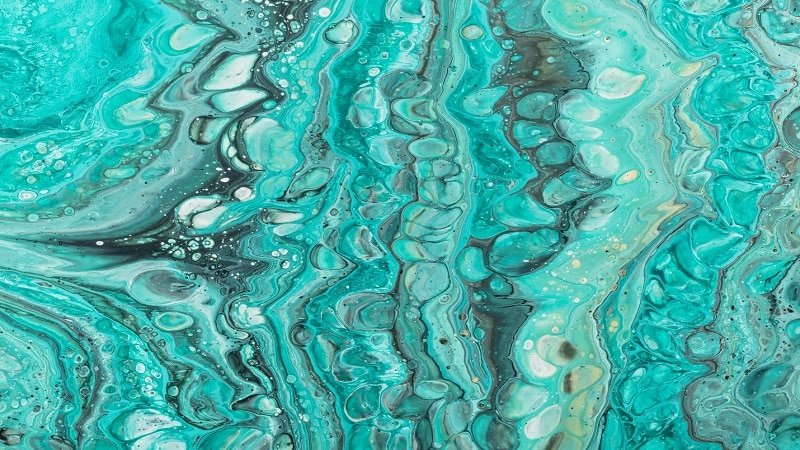What is Turquoise?

When you think of turquoise, a bright blue color comes to your mind; but turquoise is originally a gemstone used in jewelry. It has been famous in eastern jewelry, giving it an ornamental and attractive look.
The gemstone has captivated people for millennia, especially in Muslim countries like Iran. It has been used in jewelry to decorating mosques, to incorporating the stone in clothing.
So what is turquoise, and how is it formed?
The Formation of Turquoise and the Mystery behind It.
Turquoise is a teal-colored mineral that can also be described as a bluish-green gemstone. Turquoise is formed from a hydrated phosphate of copper and aluminium. Now, this can seem quite difficult to break down, so let’s look at a hydrated phosphate. Hydrated phosphate is an anion or a salt that is some water content in it.
A turquoise will usually be formed when there are hydrothermal deposits of copper sulfides. The hydrothermal deposits are valuable minerals formed from hot waters that circulate from the Earth’s crust. So, in other words, when rainwater or snow infiltrates the Earth’s surface and starts filtering through the copper porphyry, that is when turquoise is formed.
This is a rare and valuable gemstone, especially if you get it in finer grades. This gemstone is one of the oldest gemstones to be discovered from the time of the ancient Egyptians. It has many different names. Such as the Roman author ‘Pliny the Elder’ referred to this gemstone as ‘callais’ while the Aztecs referred to it as ‘chalchihuitl‘. Both names sound quite difficult to pronounce, so let’s just stick to its current name, which is ‘turquoise’.
The Value of Turquoise
Turquoise is a valuable gemstone not just because of its vibrant blue color but also because of its association as of December’s birthstone and a gift for the 11th anniversary. Turquoise has been valued since the time of the ancient Egyptians. Believe it or not, it has been used from the ancient Egyptians to the Aztecs, to the Mesopotamian empire, by the Persians, and even in ancient China during the Shang dynasty.
Europe jumped on the bandwagon when it was introduced to them by Turkey. However, the gemstone’s value was appreciated only after the 1300s, when there was a decline in the Roman Catholic Church’s influence. Now, what would a church have anything to do with a gemstone. Well, turquoise was allowed by the church to be used eventually in secular jewelry.
Despite its esteemed history and use by royalty in different civilizations, turquoise is not that valued in the current era. This is evidenced by its price ranging from 1 carat, anywhere between $1 to $10. However, based on the quality of the gemstone, the price can appreciate up to $1000 for 1 carat.
The Devaluation of Real Turquoise
The reason why it is not valued anymore is that it is easier to create an imitation or a synthetic version of turquoise. You would be surprised to know that the ancient Egyptians invented the first imitation of turquoise in the glazed earthenware product known as ‘faience’ (a sintered quartz ceramic material). So, imagine that a gemstone’s artificial imitation has existed since the millennia. That is reason enough for people to not opt for the real and authentic turquoise when an imitation has been perfected to look like the real one.
The faience was replaced later by glass and enamel, whereas in modern times, plastic and porcelain are used to create close imitations of the real gemstone. An example of this is ‘Viennese turquoise’, which will seem like it is made naturally on the first appearance because it is made from hydrated aluminium phosphate, which is 50% of what is included in the actual authentic turquoise.
However, suppose you visit any jeweler’s market today. In that case, the only imitation of turquoise that you will find is dyed magnesite or a howlite, both of which are minerals and are naturally found in white color. That means it is easier to dye them into teal colors.
Cultural Associations with Turquoise
Turquoise has been considered a holy stone for many years and a talisman worn to bring good luck to the user. This claim was found in the manuscripts of ancient Egyptians who had grave furnishings with turquoise embedded in them. They even had a goddess Hathor who was associated with this gemstone, and as a consequence, she was called by titles like ‘Lady of Turquoise’ as she was the patroness of the place where the mineral was mined.
In the Persian Empire, the turquoise as a gemstone was used in jewelry, especially in pendants and bracelets, as protection from any unnatural death caused by accidents. If the turquoise changed color while the user was wearing it, it was a sign that their death was nearby. Now you could be surprised about why an authentic gemstone like turquoise would change color? But, that is purely a chemical reaction caused by light or a change in the skin’s PH level. A gemstone’s changing color is not a sign of impending danger.
Our Final Thoughts
Turquoise is not valued like other gemstones. Only true gem collectors understand the value of turquoise and the special chemical reaction needed to form.
So, the next time you might want to get a raw turquoise (Amazon ASIN #B0912M5QF4) that is also known to have healing powers to calm the user and bring them good fortune for their future. So make yourself feel like royalty by having this gemstone because, after all, you are having a part of history in your hands.